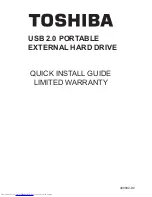
AT3550 User Guide V1.00
February 11, 2005
page 13 of 16
4.4 TROUBLE SHOOTING GUIDE
4.4.1 SELF-TEST DIAGNOSTIC CODES
The AT3550 has been designed to issue blink codes via the LED in the event of a
low-level or catastrophic failure. A blink code of five would be defined as five fast
blinks, a pause with no blinks, and a repeat of the process. The drive will not
respond to commands or a soft reset when in this state. Only powering down the
drive will clear the drive state and restart internal diagnostics.
Blink codes and their associated failure mechanisms are defined below. In the
event a blink code is encountered, contact the factory for further assistance.
Number of
Blinks
Error
2
ROM Firmware Checksum error
3
ASIC initialization error
4
SRAM Test failed
5
IDE buffer failure
6
IDE controller error
7
NRZ data path error
4.4.2 UNCORRECTABLE ERRORS
If a drive has been subjected to a power down during a write command, or as
been run under marginal or dirty power conditions, uncorrectable errors may be
introduced into the media. This may result in data read errors, a corrupted FAT
table entry or directory, or an invalid boot partition or partition table. Microsoft
®
Scandisk or Norton Disk Doctor
™
will successfully correct FAT table problems and
partition table errors, but should not be allowed to mark a sector in the data area
as bad. On a rewrite to a data sector with uncorrectable errors, all synchronization
and ECC codes will be rewritten and the error will be eliminated.
5. MAINTENANCE
No maintenance is required during the normal use of this drive.
If data is to be archived for long periods of time (> 10 years), it is recommended
that the data on the drive be refreshed every 5 to 10 years. The manufacturer of
the NAND E
2
PROM devices will only guarantee data integrity for a period of 10
years. Programs such as Norton Speedisk
©
, which reallocates all sectors on the
drive, or Microsoft
®
Scandisk, which writes and reads every sector on the disk
during its surface test, achieve this end very well.


































